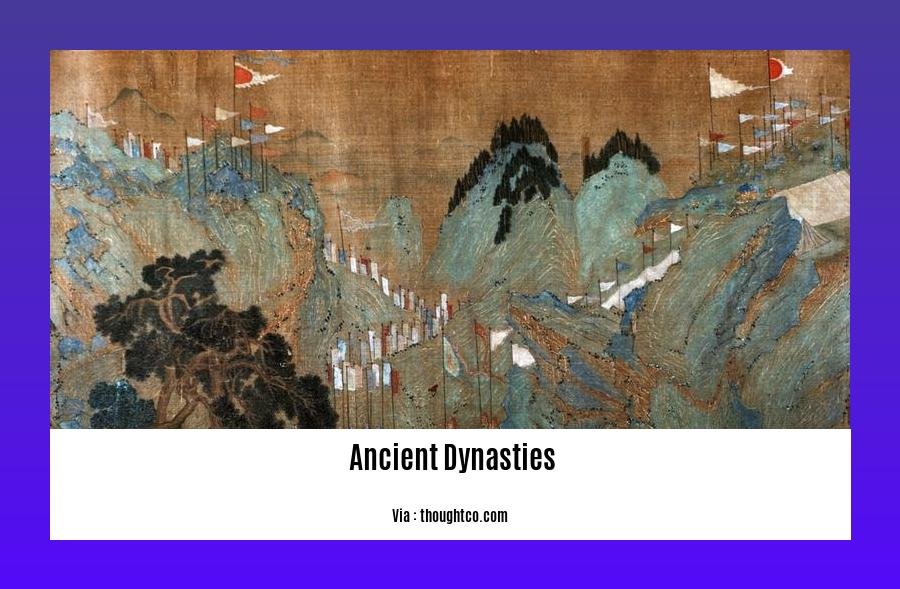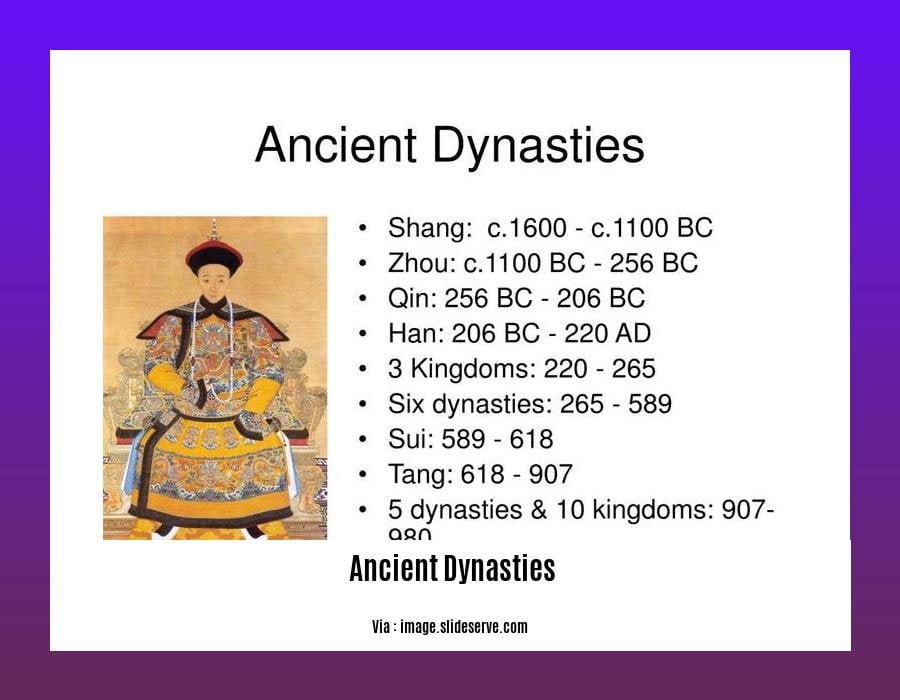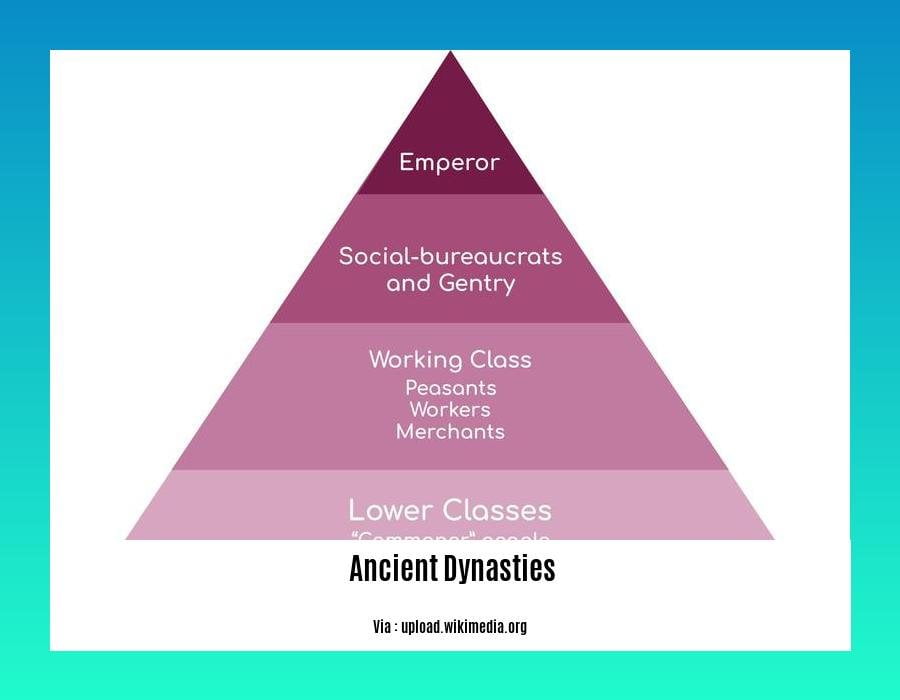Embark on a captivating journey into the enigmatic realm of ancient dynasties with [- Unveiling the Ancient Dynasties: A Journey into History and Archaeology]. Our esteemed historian and archaeologist guides us through a labyrinth of archaeological discoveries and historical texts, deciphering the intricate tapestry of legendary empires.
Key Takeaways:
- A dynasty refers to a succession of rulers from the same family or lineage.
- Dynasties are often named after the reigning family or their area of dominance.
- Dynasties play a significant role in shaping civilizations by establishing laws, government systems, and cultural traditions.
- Examples of prominent dynasties include:
- Chinese Xia, Shang, Zhou, Qin, and Han Dynasties
- Egyptian Ptolemaic and Roman Dynasties
- Macedonian and Roman Empires
Exploring Ancient Dynasties

Discover the enigmatic world of ancient dynasties, where the rise and fall of empires shaped the course of civilization.
Defining Dynasties:
A dynasty is a succession of rulers from the same lineage or family. They often bear the name of the ruling family or the region they dominated.
Significance of Dynasties:
Ancient dynasties were central to the development of civilizations. They established governance systems, implemented laws, and fostered cultural traditions that left an enduring legacy.
Notable Examples:
- Chinese Dynasties: Xia, Shang, Zhou, Qin, Han
- Egyptian Dynasties: Ptolemaic, Roman
- Macedonian and Roman Empires: Alexander the Great, Julius Caesar
Unveiling their Secrets:
Historians and archaeologists delve into diverse sources to unravel the mysteries of ancient dynasties:
- Archaeological Artifacts: Excavations reveal material remains, providing insights into their daily lives, technology, and beliefs.
- Ancient Texts: Inscriptions, scrolls, and tablets preserve written accounts of their history, laws, and religious practices.
- Historical Evidence: Analysis of coins, seals, and other records helps reconstruct political events and socio-economic conditions.
Exploring their Impact:
Understanding ancient dynasties allows us to appreciate the diverse cultures, innovations, and challenges that shaped the tapestry of human history. Their legacy continues to inspire us today.
Learn about the rich and fascinating history of China, from its ancient origins to the present day.
Explore the grandeur of Imperial China and discover the remarkable achievements of its dynasties.
Delve into the complex and dynamic modern Peoples Republic of China and its journey toward becoming a global superpower.
Key Events in Ancient Dynasties

Imagine stepping back into time and witnessing the grandeur of ancient dynasties, where powerful rulers shaped the destiny of civilizations. These dynasties were not merely successions of rulers but intricate tapestries woven with groundbreaking events that left an enduring imprint on our world.
Rise of the Xia Dynasty
The Xia Dynasty (c. 2070-1600 BCE) marked the dawn of Chinese civilization along the fertile basins of the Yellow and Yangtze Rivers.
Bronze Age Innovations of the Shang Dynasty
The Shang Dynasty (c. 1600-1046 BCE) ushered in the Bronze Age, showcasing remarkable craftsmanship in intricate bronzeware and intricate rituals that reflected their reverence for ancestors.
Political Evolution of the Zhou Dynasty
The Zhou Dynasty (c. 1046-256 BCE) brought about a shift from hereditary rule to feudalism during the Western Zhou period. However, the Eastern Zhou period witnessed political fragmentation and intellectual brilliance.
Civil Wars and Rise of Regional Powers
The Spring and Autumn Period (c. 771-476 BCE) was characterized by constant warfare among feudal states, leading to the rise of influential regional powers.
Unification Under the Qin Dynasty
The Qin Dynasty (c. 221-206 BCE) under Emperor Qin Shi Huang unified China for the first time, establishing a centralized government and embarking on massive construction projects like the Great Wall.
Unveiling the Secrets of Ancient Dynasties
To unravel the enigmatic stories of ancient dynasties, historians and archaeologists rely on:
- Archaeological Artifacts: Material remains that offer glimpses into daily life, technological advancements, and religious beliefs.
- Ancient Texts: Inscriptions, scrolls, and tablets provide invaluable insights into history, laws, and religious practices.
- Historical Evidence: Coins, seals, and records shed light on political events and socio-economic conditions.
Key Takeaways:
- Ancient dynasties played a pivotal role in the development of civilizations, establishing governance, laws, and cultural traditions.
- The rise of the Xia Dynasty marked the beginning of Chinese civilization.
- The Shang Dynasty introduced the Bronze Age and elaborate rituals.
- The Zhou Dynasty witnessed political evolution from hereditary rule to feudalism.
- The Spring and Autumn Period was characterized by civil wars and the rise of regional powers.
- The Qin Dynasty unified China under Emperor Qin Shi Huang and embarked on ambitious projects like the Great Wall.
Sources:
Legacy of Ancient Dynasties
Ancient dynasties have left an indelible imprint on human history, shaping civilizations, fostering innovation, and laying the foundations for modern society.
Historical Significance
Dynasties were extended ruling families or groups that held dominion over vast territories. They played a pivotal role in developing governance systems, establishing laws, and perpetuating cultural traditions. Notable examples include the Xia, Shang, and Zhou dynasties in China; the Ptolemaic and Roman dynasties in Egypt; and the Macedonian and Roman Empires under Alexander the Great and Julius Caesar.
Unearthing the Past
Archaeological excavations, ancient texts, and historical evidence provide valuable insights into these vanished worlds. Material remains such as pottery, tools, and weapons offer glimpses into everyday life, while inscriptions, scrolls, and tablets document history, laws, and religious practices. Coins, seals, and official records shed light on political events and socioeconomic conditions.
Cultural Impact
Understanding ancient dynasties helps us appreciate the diversity of cultures that have flourished throughout history. The artistic achievements, religious beliefs, and philosophical ideas of these civilizations continue to inspire and inform contemporary society.
Key Takeaways:
- Ancient dynasties played a crucial role in shaping human history, developing civilizations, and establishing governance.
- Archaeological artifacts, ancient texts, and historical evidence provide valuable insights into these vanished worlds.
- Understanding ancient dynasties helps us appreciate diverse cultures, innovations, and challenges that have shaped human history.
Relevant Sources:
Comparison of Ancient Dynasties
Let’s delve into the captivating world of ancient dynasties, where power, legacy, and human ingenuity intertwined. Across the globe, these dynasties shaped civilizations, leaving an enduring mark on our cultural tapestry.
Key Takeaways:
- Ancient dynasties represent ruling families or lineages that held sway over vast regions or countries.
- They played a crucial role in establishing governance, laws, and cultural traditions that influenced subsequent societies.
- Archaeological artifacts, ancient texts, and historical evidence provide valuable insights into their lives, customs, and achievements.
- By exploring the rise and fall of ancient dynasties, we gain a deeper understanding of the diverse cultural threads that make up our shared human history.
Similarities between Ancient Dynasties
Despite their geographical and temporal differences, ancient dynasties shared some striking similarities:
- Centralized Rule: Many were highly centralized, with a single ruler or family wielding supreme authority.
- Bureaucracies: Dynasties often established sophisticated bureaucracies to govern their territories effectively.
- Meritocracy: Some implemented meritocratic systems, where individuals were appointed to positions based on ability and achievement.
- Cultural Legacy: They left behind remarkable artistic, architectural, and technological achievements that continue to inspire today.
Differences between Ancient Dynasties
However, these dynasties also exhibited distinct differences, reflecting their unique geographical and cultural contexts:
- Geographical Dispersion: While some empires, like the Roman, spanned vast continents, others, like the Han Dynasty in China, were largely confined to specific regions.
- Duration: Dynasties varied significantly in their duration, from the long-lived Zhou Dynasty in China (lasting over 800 years) to the shorter-lived Qin Dynasty (lasting only 15 years).
- Religious Influences: The official religions of dynasties varied, shaping their social and cultural values. For instance, Christianity played a significant role in the Roman Empire, while Confucianism and Buddhism influenced the Han Dynasty.
Conclusion
Exploring the Comparison of Ancient Dynasties offers a fascinating glimpse into the complexities of human civilization. Through their rise, reign, and eventual decline, these dynasties left an indomitable mark on our collective past, inspiring awe and wonder in generations to come.
Citations:
FAQ
Q1. What is a dynasty?
A1. A dynasty is a series of rulers sharing a common lineage or belonging to the same family.
Q2. What is the significance of dynasties in history?
A2. Dynasties play a pivotal role in shaping civilizations by establishing government systems, laws, and cultural traditions.
Q3. What are some of the most famous dynasties in history?
A3. Some of the most famous dynasties in history include the Chinese Xia, Shang, Zhou, Qin, and Han Dynasties, as well as the Egyptian Ptolemaic and Roman Dynasties.
Q4. How can archaeologists help us understand ancient dynasties?
A4. Archaeologists analyze archaeological artifacts, interpret ancient texts, and synthesize historical evidence to reconstruct the rise, reign, and fall of ancient dynasties.
Q5. Why is it important to study ancient dynasties?
A5. Studying ancient dynasties helps us understand the evolution of human societies, the development of cultural traditions, and the complexities of political power.
- Star Ring Trends: Etsy vs Amazon - March 28, 2025
- Boost Pollinator Habitats: Baby Blue Eyes Sustainable Farming Guide - March 28, 2025
- Protect Big Black Bears: Effective Conservation Strategies - March 28, 2025
















